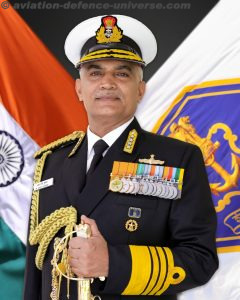- Indian Navy’s indigenization gives food for thought
By Maj Gen (Dr.) Ashok Kumar, VSM (Retired)

New Delhi. 04 December 2022. India had become a major importer of the defence equipment in the world resulting not only in huge outgo of critical finances but also jeopardising national security in the long term. The possibility of assured supply of imported arms, ammunition and other warlike stores remains suspect and therefore may result in catastrophic implications. The country has looked at these challenges seriously. It has embarked upon a major mission mode indigenisation drive wherein it has issued three negative lists restricting the imports in those fields besides issuing out four positive lists planned to be indigenised which cover more than 400 items. Not only this, the country has focussed on defence exports wherein it has already exported defence related items over 10,000 cr in financial year 21-22 and has targeted 35000cr worth of defence exports by the end of financial year 2024-25. The current trends and focus indicate that these targets can be achieved if some related issues are comprehensively addressed on priority.
The changing nature of warfare necessitates highly technologically superior equipment to ensure the winnability in the war. Whether the country produces the equipment for its domestic needs or for the exports, superior technology availability will remain a constant factoras well as a challenge. While India has made major strides in certain domains but lot still needs to be done in some other fields. The R&D focus is likely to result in deriving technological outputs but it will require additional investments besides needing substantial time to make multiple breakthroughs. The nation has not only to move ahead on the technology infusion curve but needs continuously to stay ahead so as to remain relevant.
In addition to the Army which itself has variety of equipments, Indian Navy has also embarked on major effort of indigenisation. In addition to various platforms, Indian Navy has recently produced an aircraft carrier with more than 70 percent of indigenous parts. As Indian Navy is in the need of multiple platforms including additional aircraft carrier to thwart the challenges arising from PLAN not only in the Indian Ocean but elsewhere as well. Such needs can be only met if we have defence technologists in adequate Nos for which it has to be introduced in majority of engineering colleges at the graduation level . Additional vacancies will also be needed in this field at the MTech level.
It is also equally important to have skilled manpower to execute engineering marvels and excellence in technology implementation practices. Unless skilled manpower is available that too locally, it is a humongous task to meet indigenous tarhets. The engineering colleges, skilling centres and ITIs need to re-energise skilling needs though much more needs to be done than what is being currently attempted. Two recently announced defence corridors , one in Tamilnadu and the other in UP will have such challenges. While skilling in the Tamilnadu Defence corridor may not face such serious challenges but the same is likely to be a major constraint in the development of Defence corridor in UP.
When the Defence corridors were announced in UP, two of its six nodes were planned in the Bundelkhand region viz in Jhansi and Chitrakoot. These are aimed not only for enhancing the Defence manufacturing in India but also intended to address the developmental needs of UP in general and Bundelkhand in particular. It will be possible only if skilled manpower is locally available as only then the income levels of locals will increase besides this being more economical to the industry as they will not be required to bear the re-location cost.
To meet these requirements and all other related conditions, the conventional approach relates to creation of adequate seats of engineering wherein number of vacancies in the individual subject branches could be related to likely demands in those subject specialties. The requirements have to be calculated nationally including HR demand in these specialties in our friendly foreign countries as well. This conventional approach will not meet the requirement of Defence technology. There will be large requirement of experts/engineers especially when the country has embarked on the comprehensive expansion in this field not only for its own requirement but also for friendly foreign countries. Not only this, this requirement will continue to exist for times to come.
In addition to Army and Navy, Indian Airforce is in crying need of high quality fighter aircrafts, transport fleet with varying capacities, surveillance helicopters as well as other Airborne platforms to handle the collusive threat from China and Pakistan. It has to give fresh impetus to LCA project besides working in mission mode for other projects. To give it desired pace, it is inescapable to have large No of defence technologists employed for the purpose. It will be possible only if this course is launched in multiple engineering colleges without further delay. Of course, M Tech courses with enhanced vacancies are also needed.
It is therefore evident that a fresh approach is needed to develop inquisitive skill sets totally aligned to Defence manufacturing. The current engineering skills like Electrical, Mechanical, Electronics and Tele Communication, IT networking, Computer Science and so many others develop the future professionals in a compartmentalised manner though the first year in all these subjects have some common syllabi with enhanced awareness of other subjects also. The balance years are totally focused on the specific branch of engineering which results in hiring multiple people besides enhancing the need for integration and this is so even for the middle level of difficulty resolution.
The new approach of engineering has to be evolved akin to graduation in medicine wherein a MBBS student is exposed to all the aspects of medicines and surgery, except of course those lacking specialists/super specialists intervention. The MBBS student after internship can handle all type of patients not needing higher end intervention. Majority of patients don’t need intervention of specialists and super specialists and this model provides optimum utilisation of human resources. There is a need of looking at engineering subjects as well accordingly, more so those having defence manufacturing connections.
It will be therefore more appropriate to introduce a new discipline of engineering as ‘ Defence Technology’ at the graduation level wherein the syllabus is structured in a manner not only to have amalgamation of all engineering subjects needed in the R&D and manufacturing in the Defence industries but the syllabi has weightage of varying content as per this need.
This need has been felt more recently wherein DRDO has provided impetus to this subject and few colleges/universities have commenced M.Tech programmes in Defence Technology. Given the predominant need , the subject has to be introduced at the graduation level and that too in the majority of engineering colleges. These could commence from all the IITs from the next academic session followed by regional engineering colleges both in the government as well as the private sector. The ecosystem so created will be fully transformational and will become the key driver for achieving the aim set forth in ‘Make In India’ as well as Aatmanirbhar Bharat. This approach will be able to fully realise the potential of indigenisation and making India the world leader in the Defence domain.
The technologies so developed will not only address the needs of security and Defence but will also offer such technologies for dual/multiuse bringing in substantial development in all other fields and thus making the nation progress towards its intended mission. It is therefore urgent that Defence Technology be introduced as a new engineering subject at the graduation level.
(Maj Gen Ashok Kumar, VSM (Retd) is a Kargil war veteran and defence analyst. He is visiting fellow of CLAWS and specialises on neighbouring countries with special focus on China. The views in the article are solely the author’s. He can be contacted at editor.adu@gmail.com).

































































































































